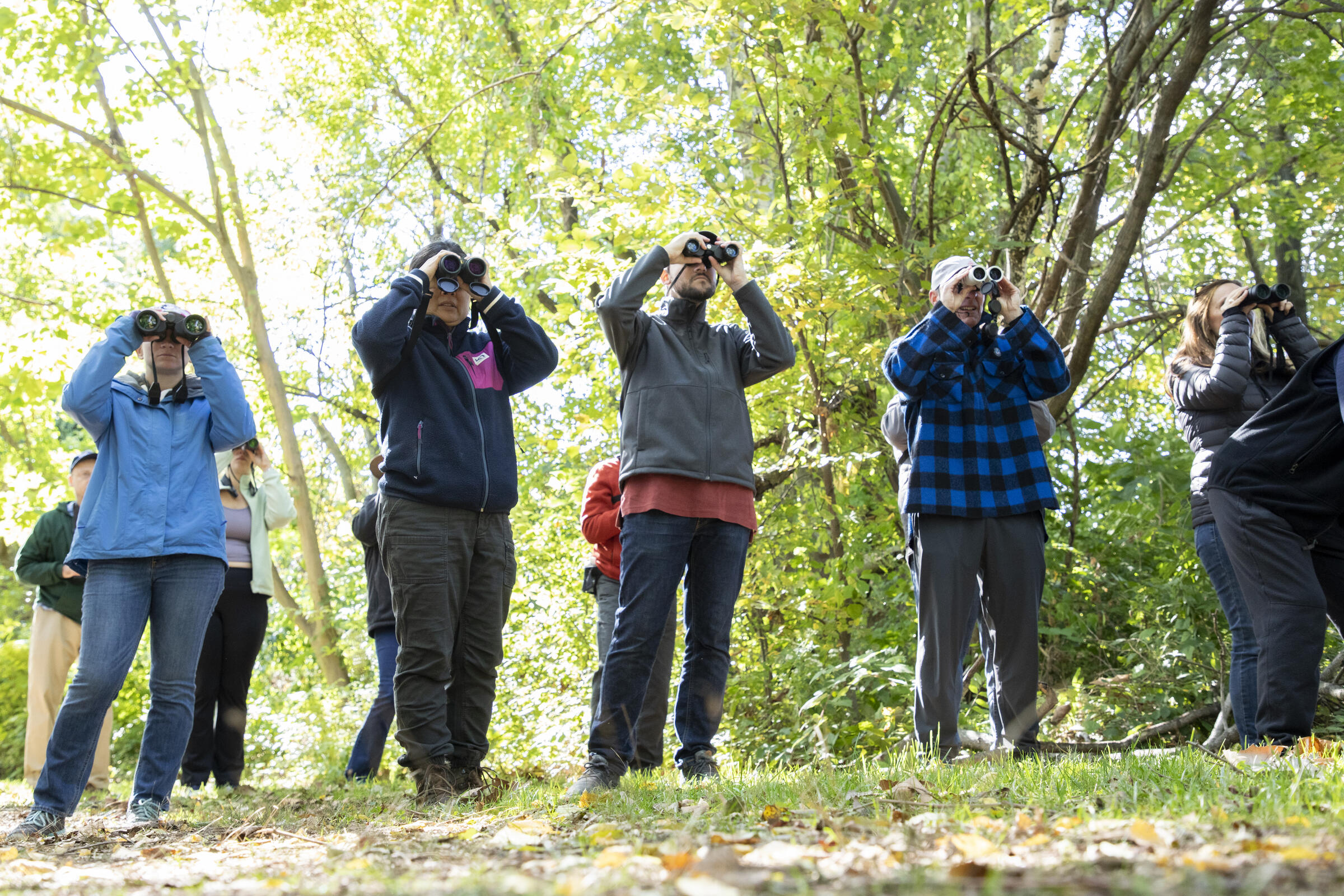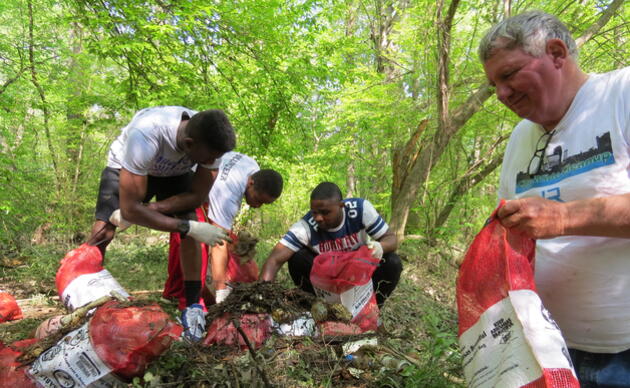AIRPORT
Little Rock Audubon Center & Gillam Park
4500 Springer Blvd.
501-244-2229
One of the National Audubon Society's centers and the Arkansas headquarters for Audubon Delta. Mississippi Kite, Common Yellowthroat, Blue Grosbeak, and Indigo Bunting are reliable in summer. A pair of Painted Buntings have held a territory for the last few years. In winter, watch for various sparrows hiding in the tall grass. Gillam Park is a local hotspot for spring and fall migrants. Volunteers help manage a Purple Martin colony behind the Center. Four Chimney Swift towers provide a place for this species to nest and roost. Around sunset in September and early October, you can watch swifts swirl around the tower in front of the center before darting in for the night.
Little Rock Port
Fourche Dam Pike
From the Fourche Dam Pike exit of I-440, head south. The Port is to the east (left) along Lindsey Rd. You can also cruise Frazier Pike to the east and west of Fourche Dam Pike. Look for shorebirds and waterfowl in flooded fields in fall and winter. Western Kingbirds and Scissor-tailed Flycatchers nest on utility poles and sometimes hybridize in summer. Throughout the year, see Loggerhead Shrikes, American Kestrels, and Great-tailed Grackles; there is often a grackle or two at the Valero gas station. This is roadside birding in an industrial area, so watch for traffic and pull off the road.
David D. Terry Lock and Dam
W. Damsite Rd.
34.673268, -92.169602
Enter from the west side of the Arkansas River on W. Damsite Rd, off Frazier Pike. In spring, the woods along the road can be excellent for migrants. Painted Bunting is reliable at the end of the road. Look for gulls, terns, cormorants, and pelicans on the river.
DOWNTOWN
William J. Clinton Presidential Center and Park
1200 President Clinton Ave.
While visiting the Clinton Presidential Center, spend time strolling the grounds. Along the Arkansas River, look for ducks, herons, egrets, and eagles. Baltimore Orioles nest in the riverside trees. At the William E. "Bill" Clark Presidential Wetlands, a 1,600-foot boardwalk forms a loop trail around 13 acres of restored wetland named after an avid outdoorsman and civic solid, charitable, and political leader.
Riverfront Park
202 La Harpe Boulevard
This multi-use park lies between the Arkansas River Trail and the River Market District. It offers playgrounds, art, a theater, and more. Look for ducks and geese on the Arkansas River. Many birds use the Arkansas River as a travel corridor, so keep an eye out for Bald Eagles, belted Kingfishers, and, during migration, flocks of Eastern Kingbirds. A variety of swallows pick insects out of the air over the river.
MIDTOWN
Knoop Park
20 Ozark Point
This city park's paved trail is 0.7 miles one-way. It slopes on either end but is generally easy to walk. Halfway along its length, there is an overlook with a fantastic view of downtown Little Rock and the Arkansas River. Spring migrants are the main attractant; the park has an impressive species list for its size. Raptors and large waterbirds may be visible from the overlook. You never know what you may find here, such as a wintering Wilson's Warbler or a late Least Flycatcher.
Allsopp Park
3700 Cedar Hill Road
This city park has a combination of paved walkways and natural wooded trails. Birders share the trails with hikers, dog walkers, and mountain bikers. It can be great for migratory songbirds such as warblers and thrushes, especially along the stream that parallels the trail from the Cantrell Road entrance to the Kavanaugh promenade.
Boyle Park
2000 Boyle Park Road
This wooded city park is listed in the National Register of Historic Places because of structures built by the Civilian Conservation Corps in the 1930s. The woods and Rock Creek attract various birds, especially during migration. All three nuthatch species, five species of thrush, six species of vireo, and more than 25 warbler species are possible. Resident Red-headed Woodpeckers are sometimes seen.
WEST
Two Rivers Park
6900 Two Rivers Park Road
A 1,000-acre county park at the Arkansas and Little Maumelle Rivers confluence. The park has many amenities, including bike trails, walking trails, a community garden, and abundant wildlife. Various waterbirds can be seen from the bridge and shoreline, including rarities like Long-tailed Duck. Marshbirds like Virginia Rail, Sora, and Marsh Wren are possible in the wetland. Sparrows, including Clay-colored and buntings, can be found in the fields and shrubby areas. Check out the community garden for open country birds like Eastern Bluebirds, Purple Martins, and butterflies. Always be aware of the pedestrian and bike traffic. Early mornings may be best to avoid the crowds. This park can be too crowded on nice days, and events draw even bigger crowds.
William Kirsch Preserve within Ranch North Woods
8813 Ranch Boulevard
The Nature Conservancy's urban preserve offers 3.5 miles of trails wandering through fields and forests and 1.7 miles along the Little Maumelle River, including a canoe trail with a floating canoe campsite. The woodlands, grasslands, and wetlands make for an exciting mix of birds. Look for raptors overhead and waders along the river. Wintering sparrows skulk in dense vegetation. Prothonotary Warblers nest here, while Red-headed Woodpeckers are here year-round.
Pinnacle Mountain State Park
11901 Pinnacle Valley Road
This trendy park boasts a species list of over 200 birds. During migration, 32 warblers and most of the state's vireos, thrushes, and buntings are possible. Listen for Barred, Great Horned, Eastern Screech-Owls, and Chuck-will's-widows and Eastern Whip-poor-wills in the evening. Brown-headed Nuthatches occur wherever there are pines. The observation platform above the visitor center overlooks the Maumelle and Arkansas Rivers; from there, look for soaring raptors above and waterbirds below.
Lake Maumelle
11800 Maumelle Harbour Rd., Roland
This is Little Rock's drinking water supply. Central Arkansas Water protects water quality by securing and managing land in the watershed. Boating is allowed, but swimming is not. Birding is usually done by hopping from one access point to another along the south shore - Bufflehead Bay/Marina, Loon Point/Farkleberry Trail, Hundley Road Causeway, and Vista Park. Lake Maumelle is most noted for its concentrations of loons. Common Loon is the most common, with upwards of 80 seen in a day. Red-throated Loons are rare but almost regular. Pacific and Yellow-billed have been documented here, too. In winter, you may also see decent numbers of ducks, including rare ducks like long-tailed ducks or any of the three scoters. Brown-headed Nuthatches and a variety of songbirds occupy the surrounding woods. A spotting scope is recommended.
SOUTHWEST
Hindman Park
7501 Hindman Park Way
Hindman Park is 210 acres of gently rolling, tree-covered land adjacent to Brodie Creek. It was a golf course until 2019. The former greenways make it easy to meander and search for birds among the groves of trees. The scattered pines are home to Red-headed Woodpeckers and Brown-headed Nuthatches. Rusty Blackbirds are reliable in winter. A variety of warblers, vireos, and flycatchers are possible during migration.
Western Hills Park
5207 Western Hills Ave
This city park and former golf course have golf paths that provide access to the banks of Fourche Creek on the far side of the parking lot. Biking and fishing events are held there. Chimney Swifts roost and nest in an old silo. Multiple raptor species, including (rarely) Merlin, are possible. Multiple woodpecker species occur here year-round including Red-headed. Open country birds include Yellow-breasted Chat, Bell's Vireo, Blue Grosbeak, and Indigo Bunting. Many sparrow species are possible, and even more warblers.
Benny Craig Park
4610 Gum Springs Rd.
This 22-acre city park lies along Fourche Creek. A concrete ramp provides access to floatCreekcreek. Bird the paved trail along the edge ofCreekCreek and the rest of the park's perimeter. Brown-headed Nuthatches are possible in the pines at any time of year. In winter, Red-breasted Nuthatch and rusty blackbirds are possible, too. Sparrows inhabit the park's brushy borders. Winter Wrens sing from the bottomlands on the east side.
Interstate Park
3900 S Arch St.
This 71-acre city park is adjacent to Fourche Creek and Fourche Bottoms. Swaggerty Creek flows through the middle. The park serves primarily as a ballfield complex. It also has a boat ramp for access to Fourche Creek. Scan the fences and stadium lights for perched birds. Scan Swaggerty Creek and the western perimeter's dense tangles for sparrows, Hermit Thrushes, and Winter Wrens. There can be 1flocks of Killdeer and blackbirds present throughout the winter.




